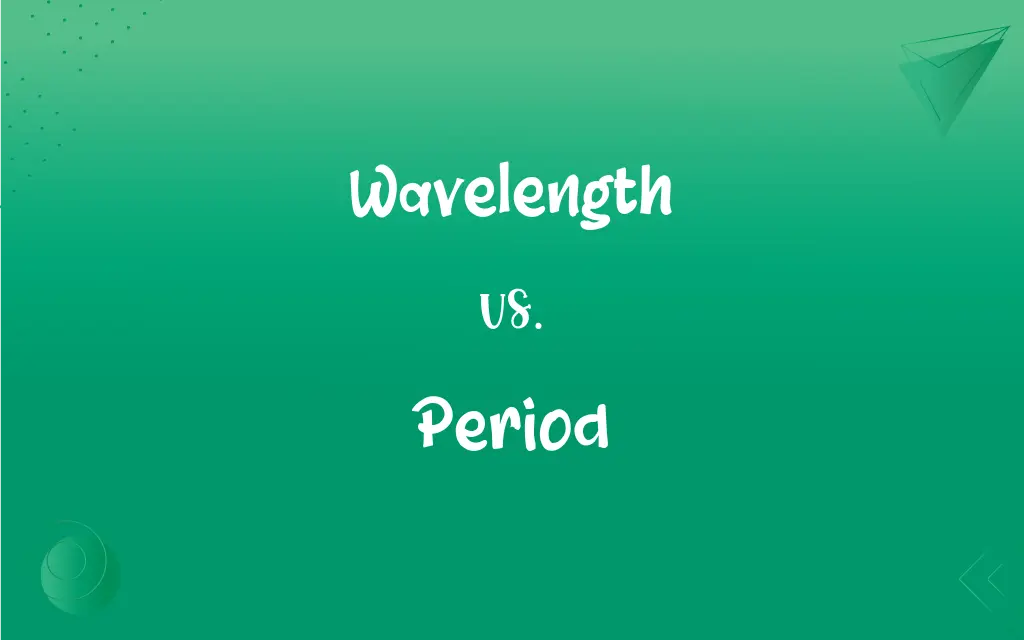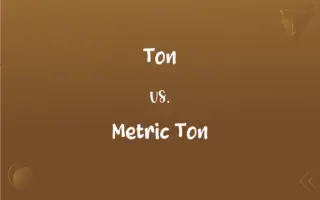Wavelength vs. Period: What's the Difference?
Edited by Janet White || By Harlon Moss || Updated on October 17, 2023
Wavelength is the distance between successive peaks of a wave, while period is the time it takes for one cycle of the wave to complete.

Key Differences
Wavelength refers to the spatial distance between two successive points that are in phase on a wave, such as between two peaks or two troughs. It essentially measures how long a wave is in space. On the other hand, period pertains to time and indicates how long it takes for one complete cycle of a wave to pass a certain point.
When observing a wave, the wavelength can be visualized as the length from one crest to the next or from one trough to the subsequent one. This distance, whether measured in meters, centimeters, or any other unit of length, gives a spatial characterization of the wave. Conversely, the period is all about timing. It reveals the duration it takes for those two successive crests or troughs (i.e., one complete wave cycle) to pass by a stationary observer.
In many wave phenomena, such as light or sound waves, both wavelength and period play crucial roles. For instance, in the spectrum of visible light, different colors correspond to different wavelengths. Red light has a longer wavelength than blue light. However, the period of each color of light would indicate how much time elapses during one full oscillation of that specific light wave.
In mathematical terms, wavelength and period are inversely related for a given wave speed. If the wavelength increases (meaning the wave gets "stretched out" more), the period will decrease because the wave takes less time to complete one cycle. Similarly, if the wavelength decreases (the wave becomes "compressed"), the period will increase since the wave requires more time to undergo one full cycle.
Comparison Chart
Definition
Spatial distance between two points in phase on a wave
Time for one complete cycle of a wave
ADVERTISEMENT
Units
Units of length (e.g., meters, centimeters)
Units of time (e.g., seconds, milliseconds)
Relation to Frequency
Inversely proportional (i.e., higher frequency means shorter wavelength)
Inversely proportional (i.e., higher frequency means shorter period)
Visualization
Distance from crest to crest or trough to trough
Time duration between two successive crests or troughs passing a point
Significance
Determines properties like color (for light)
Determines oscillation speed of a wave
Wavelength and Period Definitions
Wavelength
The spatial interval of a periodic wave.
In radio frequencies, the wavelength can be several meters long.
ADVERTISEMENT
Period
A measure of the duration of one oscillation of a wave.
Waves with shorter periods oscillate more frequently.
Wavelength
The physical distance over which a wave's shape repeats.
The shorter the wavelength, the higher the pitch in sound waves.
Period
The time it takes for one complete cycle of a wave to pass a point.
The period of a pendulum's swing is consistent when unaffected by external forces.
Wavelength
The length between two identical points in the cycle of a wave.
Visible light has a wavelength range from about 400 to 700 nanometers.
Period
The inverse of a wave's frequency.
A wave with a frequency of 5 Hz has a period of 0.2 seconds.
Wavelength
The distance between two consecutive points that are in phase on a wave.
The wavelength of red light is longer than that of blue light.
Period
The interval required for the phase of a wave to complete a full 360° cycle.
The period of a tuning fork's sound wave determines its pitch.
Wavelength
A measurement of how long a wave is in space.
Shorter wavelengths result in higher energy waves.
Period
The time between two successive peaks or troughs passing a fixed point.
A wave with a 2-second period takes 2 seconds to complete one full oscillation.
Wavelength
The distance between one peak of a wave to the next corresponding peak, or between any two adjacent corresponding points, defined as the speed of a wave divided by its frequency.
Period
An interval of time characterized by the occurrence of a certain condition, event, or phenomenon
A period of economic prosperity.
Wavelength
(physics) The length of a single cycle of a wave, as measured by the distance between one peak or trough of a wave and the next; it is often designated in physics as λ, and corresponds to the velocity of the wave divided by its frequency.
Period
An interval of time characterized by the prevalence of a specified culture, ideology, or technology
Artifacts of the pre-Columbian period.
FAQs
In what units is wavelength typically measured?
Wavelength is usually measured in units of length, such as meters or nanometers.
How are wavelength and period related?
They are inversely related for a given wave speed; as one increases, the other decreases.
What is the period?
Period is the time it takes for one complete cycle of a wave to pass a specific point.
Does a longer wavelength mean a longer period?
Not necessarily; they are inversely related for a given wave speed.
How does the period of a wave affect its properties?
The period, being related to frequency, affects properties like pitch in sound and color in light.
In musical terms, how is wavelength related?
In music, a note's pitch is related to the sound wave's wavelength: shorter wavelengths result in higher pitches.
What is wavelength?
Wavelength is the distance between two successive points in phase on a wave, like from crest to crest.
What determines the color of light?
The color of light is determined by its wavelength.
How can I visualize wavelength?
Imagine the distance from one wave peak to the next.
What happens to the period if the wavelength of a wave increases?
For a given wave speed, if the wavelength increases, the period will decrease.
In what units is the period typically measured?
Period is measured in units of time, like seconds or milliseconds.
How can I visualize period?
Think of the time it takes for two consecutive peaks to pass by a fixed point.
Does sound have a wavelength?
Yes, sound waves have a wavelength, determining pitch and other properties.
Is period directly related to wave speed?
No, period is inversely related to frequency, but wave speed is determined by both frequency and wavelength.
Can the period of a wave be zero?
No, a period of zero would imply an infinite frequency, which is not physically possible.
Can we change the wavelength and period of a wave?
Yes, by changing factors like medium and energy, you can alter a wave's wavelength and period.
How does the period relate to frequency?
Period is the inverse of frequency.
Can two waves have the same wavelength but different periods?
For a given medium and type of wave, a specific wavelength corresponds to a specific period.
Are wavelength and period properties of all waves?
Yes, all waves, whether electromagnetic, sound, or water waves, have a wavelength and period.
What part of the electromagnetic spectrum has the shortest wavelength?
Gamma rays have the shortest wavelength in the electromagnetic spectrum.
About Author
Written by
Harlon MossHarlon is a seasoned quality moderator and accomplished content writer for Difference Wiki. An alumnus of the prestigious University of California, he earned his degree in Computer Science. Leveraging his academic background, Harlon brings a meticulous and informed perspective to his work, ensuring content accuracy and excellence.
Edited by
Janet WhiteJanet White has been an esteemed writer and blogger for Difference Wiki. Holding a Master's degree in Science and Medical Journalism from the prestigious Boston University, she has consistently demonstrated her expertise and passion for her field. When she's not immersed in her work, Janet relishes her time exercising, delving into a good book, and cherishing moments with friends and family.































































